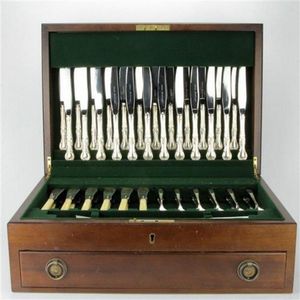Gorham Sterling Silver Cutlery Set in Mahogany Canteen
You must be a subscriber, and be logged in to view price and dealer details.
Subscribe Now to view actual auction price for this item
When you subscribe, you have the option of setting the currency in which to display prices to $Au, $US, $NZ or Stg.
- Cartouche - An ornamental panel in the form of of a shield, oval or rectangular scroll with curling edges. It may be carved into the back of a chair or the top of a sideboard, or present on a piece of silver or jewellery, and contain the initials of the original owner, heraldic symbols, or some other inscription, such as the details of a presentation.
In ceramics the term defines the central area of a vase or similar with a decorative border in one of the shapes above, into which a decorative scene or figures have been painted. - Circa - A Latin term meaning 'about', often used in the antique trade to give an approximate date for the piece, usually considered to be five years on either side of the circa year. Thus, circa 1900 means the piece was made about 1900, probably between 1895 and 1905. The expression is sometimes abbreviated to c.1900.
- Mahogany - Mahogany is a dense, close grained red-coloured timber from the West Indies and Central America. It was first imported into Europe in the the early 18th century and its use continued through the 19th century. It was popular for furniture making because of its strength, the wide boards available, the distinctive grain on some boards, termed flame mahogany and the rich warm colour of the timber when it was polished.. The "flame" was produced where a limb grew out from the trunk of the tree, and this timber was usually sliced into veneers for feature panels on doors, backs and cornices.
Some terms used to describe mahogany relate to the country from which it originally came, such as "Cuban" mahogany, "Honduras" mahogany etc. However unless the wood has been tested the names assigned are more a selling feature, rather than a true indication of the timber's origin. - Canteen - A small cabinet, table or a box with drawers or lift out trays, for storing a set of cutlery.
This item has been included into following indexes:
- American / United States silver - silver flatware, cutlery and accessories 115
- butter knife / knives - silver items 180
- carving knife / knives - silver items 61
- fruit service / set - silver items 102
- silver cutlery / flatware, makers - Gorham Manufacturing Co. (United States) 27
- silver cutlery / flatware, settings - canteens / boxes 621
Visually similar items

Large Edwardian silver plate canteen setting for twelve people, including carving set, main knives and forks, entree knives and forks, dessert spoons, soup spoons and teaspoons, all within an oak box with drawer

Silver plated cutlery service, setting for six in timber box

A cased cutlery set for six 'James' Silverpride plate EPNS A1

Silver plated cutlery setting in fitted canteen comprising Grosvenor 'Gainsborough' set of twelve main forks, twelve main knives, twelve entree forks, twelve entree knives, twelve dessert spoons, twelve soup spoons, twelve teaspoons, six coffee spoons, Wil
